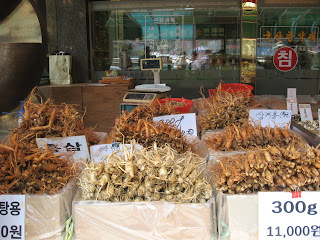The first part of the story takes place in the royal kitchen and emphasizes cooking skills based on the health characteristics of food, along with the careful preparation and selection ingredients. This traditional medical knowledge and its relationship with food becomes clearer when Jang Geum begins to study medicine and eventually becomes the King's private doctor. Her success in medical practice is related to her background in food preparation and her artistry in combining them is demonstrated in numerous scenes, such as for example when she creates an edible form of medicinal garlic for one of her patients.
Another important aspect of the series is in the names and titles used for diseases and medicines, which are in the common language spoken and understood by everyone in Korean society (although if this carries over through the multiple translations would need to be investigated). Even though there were medical institutions and pharmacies, people of the day also learned about medicine and about finding and preparing medicinal herbs from the countryside and the mountains by themselves. Rather than separating people from medical knowledge, as the academic works in the field tend to do today by way of specialized jargon, the health system depicted in the series suggests that traditional Korean medical knowledge and nutritional wisdom was understood by ordinary people as well as by the specialized practitioners.
The series also emphasizes a method of disease diagnosis from the traditional health care system that looked first and foremost at diet and nutrition. In the climax of the series, for example, Jang Geum carefully investigates from where the special food for the ailing king had come, and through that she finds out that drinking milk from cows that drank water from a sulfuric lake introduced arsenic into the patient's body, which in turn lead to his chronic illness. On another occasion, when there was an epidemic in different parts of the kingdom, the cause was traced to a vegetable blight. These aspects of the series bring to mind such modern maladies related to food, such as mad cow disease and avian flu. The difference is, however, that with today's eating habits increasingly dominated by the giant food industries, identifying and solving health problems related to food has become politically and economically inviable, if curbing unhealthy food intake can be construed as a barrier to trade or economic growth and thus liable to litigation, as was seen the McLibel Trial.
The ordinary people depicted in 'Jewel in the Palace' understand what they eat, the herbs, spices, vegetables and other ingredients in their foods. In addition to identifying ingredients, cooking skills are also related to subsidiary issues such as the change of seasons and knowledge of local flora and fauna. Even though it is a historical drama, it depicts a traditional medicine and food culture that is still part of the East Asian life and culture today, in many cases side by side with the modern sciences, which can be considered as part of the rich culture of the past that every human being can enjoy in every era. The series and its immense popularity today gives pause for reflection on the socio-economic aspects of health and indirectly suggests that the medical and nutritional wisdom of the past remains relevant.
[This review is by Yusef Progler and was originally published in 2008 as a media report in the Journal of Research in Medical Sciences, Vol. 13, No. 1, pp. 41-42. It has been edited for reprinting here. The original article is available as a PDF at the JRMS website and there are dozens of clips from the series on YouTube.]



No comments:
Post a Comment
Note: Only a member of this blog may post a comment.